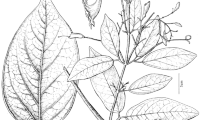Abstract
Sullivantia (Saxifragaceae) is restricted to the United States; its species occur in very specialized habitats such as wet cliffs and moist canyon walls in scattered localities from Washington and Oregon, eastward to Wyoming, Montana, Colorado, Missouri, Iowa, Illinois, Minnesota, Wisconsin, Indiana, Ohio, and Virginia. Relationships in the genus were reevaluated using data from morphology (including the use of greenhouse-grown plants), crossability, and flavonoid chemistry. The conclusion of this study is thatSullivantia comprises four morphologically similar allopatric taxa:S. oregana, S. hapemanii var.hapemanii, S. hapemannii var.purpusii, andS. sullivantii.
Similar content being viewed by others
Literature Cited
Bohm, B. A. & R. Ornduff. 1978. Chemotaxonomic studies in the Saxifragaceae s.l. 9. Flavonoids ofJepsonia. Madroño 25: 39–43.
Brandegee, T. S. 1899. New species of western plants. Bot. Gaz. 27: 444–457.
Britton, N. L. & H. A. Brown. 1897. An illustrated flora of the northern United States, Canada and the British possessions. Vol. 2. Charles Scribner's Sons, New York.
— 1913. An illustrated flora of the northern United States, Canada and the British possessions. Ed. 2. Vol. 2. Charles Scribner's Sons, New York.
Coulter, J. M. 1892.Sullivantia hapemanii, Bot. Gaz. 17: 421.
— & E. M. Fisher. 1892. Some new North American plants. I. Bot. Gaz. 17: 348.
— & A. Nelson. 1909. New manual of botany of the Central Rocky Mountains. American Book Co. New York.
Crandell, D. R. 1965. The glacial history of western Washington and Oregon. Pages 341–354.In: H. E. Wright, Jr. & D. G. Frey, editors. The Quaternary of the United States. Princeton University Press, Princeton, NJ.
Dilcher, D. L. 1974. Approaches to the identification of angiosperm leaf remains. Bot. Rev. 40: 1–157.
Erdtman, G. 1960. The acetolysis method. A revised description. Svensk Bot. Tidskr. 54: 561–564.
Flint, R. F. 1971. Glacial and Quanternary geology. John Wiley & Sons, New York.
Giannasi, D. E. 1975. The flavonoid systematics ofDahlia (Compositae). Mem. New York Bot. Gard. 26: 1–125.
Gleason, H. A. 1963. The new Britton and Brown illustrated flora of the northeastern United States and adjacent Canada. Vol. 2. Hafner Publishing Co., New York.
— & A. Cronquist. 1963. Manual of vascular plants of northeastern United States and adjacent Canada. D. Van Nostrand Co. New York.
Goldthwait, R. P., A. Dreimanis, J. L. Forsyth, P. F. Karrow & G. W. Whit. 1965. Pleistocene deposits of the Erie Lobe. Pages 85–98.In: H. E. Wright, Jr. & D. G. Frey, editors. The Quaternary of the United States. Princeton University Press, Princeton, NJ.
Gornall, R. J. 1980 Generic limits and systematics ofBoykinia and allies (Saxifragaceae). Ph.D. dissertation. University of British Columbia, Vancouver.
— & B. A. Bohm. 1980. The use of flavonoids in the taxonomy ofBoykinia and allies (Saxifragaceae). Canad. J. Bot. 58: 1768–1779.
Gray, A. 1842. Notes on a botanical excursion to the mountains of North Carolina. Amer. J. Sci. Arts 42: 1–48.
Heller, A. A. 1900. Catalogue of North American plants north of Mexico. Ed. 2.
Hideux, M. J. & I. K. Ferguson. 1976. The stereostructure of the exine and its evolutionary significance in Saxifragaceae sensu lato. Pages 327–375.In: I. K. Ferguson & J. Muller, editors. The evolutionary significance of the exine. Academic Press, London.
Mabry, T. J., K. R. Markham & M. B. Thomas. 1970. The systematic identification of flavonoids. Springer-Verlag, New York.
Metcalfe, C. R. & L. Chalk. 1950. Anatomy of the dicotyledons. Vol. 2. Clarendon Press, Oxford.
Ornduff, R. 1969. Ecology, morphology, and systematics ofJepsonia (Saxifragaceae). Brittonia 21: 286–298.
Palmer, E. J. & J. A. Steyermark. 1935. An annotated catalogue of the flowering plants of Missouri. Ann. Missouri Bot. Gard. 22: 1–794.
Rodman, J. E. 1974. Systematics and evolution of the genusCakile (Cruciferae). Contr. Gray Herb. 206: 3–146.
Rosendahl, C. O. 1927. A revision of the genusSullivantia. Minnesota Stud. Pl. Sci. 1(6): 401–427.
Rydberg, P. A. 1922. Flora of the Rocky Mountains and adjacent plains. Published by the author, New York.
Small, J. K. & P. A. Rydberg. 1905. N. Amer. Fl. 22: 81–158.
Soltis, D. E. 1980a. Flavonoids ofSullivantia: taxonomic implications at the generic level in the Saxifraginae. Biochem. Syst. Ecol. 8: 145–151.
— 1980b. Karyotypic relationships among species ofBoykinia, Heuchera, Mitella, Sullivantia, Tiarella, andTolmiea (Saxifragaceae). Syst. Bot. 5: 17–29.
— 1980c. A biosystematic study ofSullivantia and related studies in Saxifragaceae. Ph.D. dissertation. Indiana University, Bloomington.
— 1981. Variation in hybrid fertility among the disjunct populations and species ofSullivantia (Saxifragaceae). Canad. J. Bot. 59: 1174–1180.
— 1982. Allozymic variability inSullivantia (Saxifragaceae). Syst. Bot. 7: 26–34.
—, P. Neuman, T. J. Mabry, G. J. Gastony & K. M. Kerr. 1981. Flavonoids ofSullivantia (Saxifragaceae). J. Nat. Prod. 44: 50–52.
Spongberg, S. A. 1972. The genera of Saxifragaceae in the southeastern United States. J. Arnold Arbor. 53: 409–498.
Taylor, R. L. 1965. The genusLithophragma (Saxifragaceae). Univ. Calif. Publ. Bot. 37: 1–122.
Torrey, J. & A. Gray. 1840. A flora of North America. Vol. 1. Wiley & Putnam, New York.
Watson, S. 1879. Contributions to American botany. Proc. Amer. Acad. Arts 14: 213–303.
Wayne, W. J. 1966. Ice and land. Pages 21–39.In: A. A. Lindsey, editor. Natural features of Indiana. Indiana Academy of Science, Indiana State Library, Indianapolis.
— & J. H. Zumberge. 1965. Pleistocene geology of Indiana and Michigan. Pages 63–84.In: H. E. Wright, Jr. & D. G. Frey, editors. The Quaternary of the United States. Princeton University Press, Princeton, NJ.
Author information
Authors and Affiliations
Rights and permissions
About this article
Cite this article
Soltis, D.E. A revision of Sullivantia (Saxifragaceae). Brittonia 43, 27–53 (1991). https://doi.org/10.2307/2807176
Issue Date:
DOI: https://doi.org/10.2307/2807176




